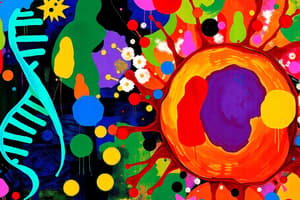Podcast
Questions and Answers
What are the large molecules that make up the bodies of organisms?
What are the large molecules that make up the bodies of organisms?
- Carbohydrates, fats, sugars, and starches
- Carbohydrates, lipids, proteins, and nucleic acids (correct)
- Minerals, vitamins, enzymes, and water
- Antigens, antibodies, hormones, and lipids
Which theory suggests that life originated from outer planets?
Which theory suggests that life originated from outer planets?
- Biological Evolution Theory
- Abiogenesis Theory
- Cosmozoic or Interplanetary Theory (correct)
- Divine Creation Theory
What is the main idea behind the theory of abiogenesis?
What is the main idea behind the theory of abiogenesis?
- Life emerged from pre-existing life
- Life was created by a divine being
- Life was imported from extraterrestrial sources
- Life originated spontaneously from non-living materials (correct)
Which statement aligns with the Divine Creation Theory?
Which statement aligns with the Divine Creation Theory?
Who first comprehensively postulated the theory of abiogenesis?
Who first comprehensively postulated the theory of abiogenesis?
Why did the Cosmozoic Theory gain little attention?
Why did the Cosmozoic Theory gain little attention?
What was Aristotle's view on the origin of specific organisms?
What was Aristotle's view on the origin of specific organisms?
What aspect of living organisms is NOT considered a general property of life?
What aspect of living organisms is NOT considered a general property of life?
Who proposed the theory of chemical evolution of life in 1924?
Who proposed the theory of chemical evolution of life in 1924?
What did the Miller-Urey experiment demonstrate in 1953?
What did the Miller-Urey experiment demonstrate in 1953?
Which scientist disproved the theory of spontaneous generation alongside Francesco Redi?
Which scientist disproved the theory of spontaneous generation alongside Francesco Redi?
What type of atmosphere did Oparin and Haldane propose for early Earth?
What type of atmosphere did Oparin and Haldane propose for early Earth?
Which of these gases was NOT part of the Miller-Urey experiment?
Which of these gases was NOT part of the Miller-Urey experiment?
What does a complementary base pairing in DNA ensure?
What does a complementary base pairing in DNA ensure?
How many hydrogen bonds link adenine to thymine in DNA?
How many hydrogen bonds link adenine to thymine in DNA?
What characterizes the organic molecules formed in the Miller-Urey experiment?
What characterizes the organic molecules formed in the Miller-Urey experiment?
Flashcards are hidden until you start studying
Study Notes
Introduction to Biology
- Biology is the science of life, leading to a focus on Zoology later in the course.
- Life is complex and cannot be simply defined; organisms display specific properties that characterize living beings.
- Organisms consist of large molecules assembled much like building blocks; key building blocks include:
- Carbohydrates and lipids (energy sources)
- Proteins (catalysts for chemical reactions)
- Nucleic acids (store hereditary information)
Theories on the Origin of Life
- Several theories exist regarding the origin of life.
Divine Creation Theory
- Claims that life was created by God, based on the Book of Genesis.
Cosmozoic or Interplanetary Theory
- Suggests life originated from outer space with protoplasmic spores, advanced by Richter (1865) and Arrhenius (1908).
- Lacks scientific experimentation to support it, thus receiving minimal attention.
Abiogenesis or Spontaneous Generation Theory
- Proposed by Aristotle, asserting that life emerged spontaneously from non-living matter (e.g., rats from rotting meat).
- This theory was disproven by Francesco Redi (1668) and Louis Pasteur (1865).
Chemical Evolution of Life Theory
- Associated with Aleksandr Oparin and J.B.S. Haldane, proposing that life developed in a warm, primordial ocean through chemical evolution.
- Organic molecules formed from non-living materials in a reducing environment, aided by external energy sources like UV radiation.
- Tested through the Miller-Urey experiment (1953), producing amino acids from a mixture resembling early Earth conditions.
Nucleic Acids and DNA Structure
- DNA consists of two complementary strands with specific base pairing:
- Adenine (A) pairs with Thymine (T) through 2 hydrogen bonds.
- Guanine (G) pairs with Cytosine (C) through 3 hydrogen bonds.
- Example of strict base pairing illustrated:
- DNA Strand 1: ATCGGCAACTCGATAGTCATT
- DNA Strand 2: TAGCCGTTGAGCTATCAGTAA
Studying That Suits You
Use AI to generate personalized quizzes and flashcards to suit your learning preferences.




